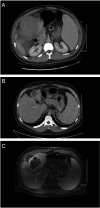Hepatic angiosarcoma five years following spontaneous intraperitoneal bleed of a hepatic mass
- PMID: 21139912
- PMCID: PMC2994458
- DOI: 10.4081/rt.2009.e33
Hepatic angiosarcoma five years following spontaneous intraperitoneal bleed of a hepatic mass
Abstract
Primary hepatic angiosarcoma is a rare and rapidly fatal disease. We present the highly unusual identification of this lesion five years after the initial clinical presentation.In 2003, a 32-year-old man presented with abdominal pain, tachycardia, and evidence of hemorrhage. A CT scan showed a hepatic mass with intralesional hemorrhage, intraperitoneal blood, and splenomegaly. The patient was stabilized clinically. Laparoscopic core biopsies demonstrated no malignancy, only findings consistent with an old hemorrhage. Contralateral lobe biopsies revealed normal liver tissue. A metastatic workup was negative and the decision was made to observe the patient clinically with radiographic follow-up, given his suspected portal hypertension based on thrombocytopenia and splenomegaly.Sequential imaging demonstrated a decrease in the size of the mass from 12.0 cm in 2003 to 3.0 cm in 2007. Subsequent newly identified esophageal varices prompted a reevaluation of the case. A repeat biopsy demonstrated a neoplasm of vascular etiology and uncertain malignant potential. By early 2008 the lesion had increased to 4.8 cm and was resected via a left hepatic lobectomy. An extremely vascular lesion with surrounding dense fibrosis was identified and pathologic examination demonstrated a high-grade angiosarcoma.We are unaware of any previous reports suggesting such a prolonged natural history of hepatic angiosarcoma. This case may represent the possibility of malignant transformation of a lower grade vascular neoplasm such as hepatic epithelioid hemangioendothelioma to an angiosarcoma.
Keywords: hepatic angiosarcoma; hepatic mass; spontaneous intraperitoneal bleed..
Conflict of interest statement
Conflict of interest: the authors report no conflicts of interest.
Figures



References
-
- Mark RJ, Poen JC, Tran LM, et al. Angiosarcoma. A report of 67 patients and a review of the literature. Cancer. 1996;77:2400–6. - PubMed
-
- Mani H, Van Thiel DH. Mesenchymal tumors of the liver. Clin Liver Dis. 2001;5:219–57. viii. - PubMed
-
- Molina E, Hernandez A. Clinical manifestations of primary hepatic angiosarcoma. Dig Dis Sci. 2003;48:677–82. - PubMed
-
- Koyama T, Fletcher JG, Johnson CD, et al. Primary hepatic angiosarcoma: findings at CT and MR imaging. Radiology. 2002;222:667–73. - PubMed
-
- Louagie YA, Gianello P, Kestens PJ, et al. Vinylchloride induced hepatic angiosarcoma. Br J Surg. 1984;71:322–3. - PubMed
LinkOut - more resources
Full Text Sources

